Matcha
Matcha’s Calming Effects on Anxiety Relief

Do you ever feel overwhelmed and anxious? We’ve all been there, searching for natural remedies to help ease our worries.
One popular option that has gained attention is matcha. Yes, that vibrant green powdered tea that has become a trendy beverage.
But can matcha really help with anxiety? In this article, we’ll explore the potential benefits of matcha for anxiety and discuss the scientific studies behind it.
We’ll also provide practical tips on how to incorporate matcha into your daily routine to promote a sense of calm and well-being.

So, if you’re curious about whether matcha could be your new anxiety-relieving ally, keep reading!
Key Takeaways
- Matcha is a powdered green tea known for its vibrant green color and unique flavor.
- Scientific studies have shown that matcha compounds, such as L-theanine, can promote relaxation and reduce stress.
- Matcha consumption has been linked to a reduction in anxiety levels.
- Matcha’s ritualistic preparation process can help calm the mind and alleviate anxiety.
What Is Matcha
First, let’s understand what matcha is. Matcha is a type of powdered green tea that’s made from the leaves of the Camellia sinensis plant. It originated in China but gained popularity in Japan, where it’s now an integral part of their traditional tea ceremony. Matcha is known for its vibrant green color and unique flavor.
Matcha is packed with antioxidants, vitamins, and minerals, making it a healthy choice for those seeking to improve their well-being. It contains high levels of catechins, a type of antioxidant that helps protect the body against damage from free radicals. These antioxidants have been linked to several health benefits, such as reducing the risk of chronic diseases and improving heart health.
In addition to its health benefits, matcha is also incredibly versatile and can be used in various recipes. From lattes and smoothies to baked goods and desserts, matcha adds a distinct flavor and vibrant green hue to any dish. Its earthy and slightly bitter taste pairs well with ingredients like coconut milk, honey, and citrus fruits.
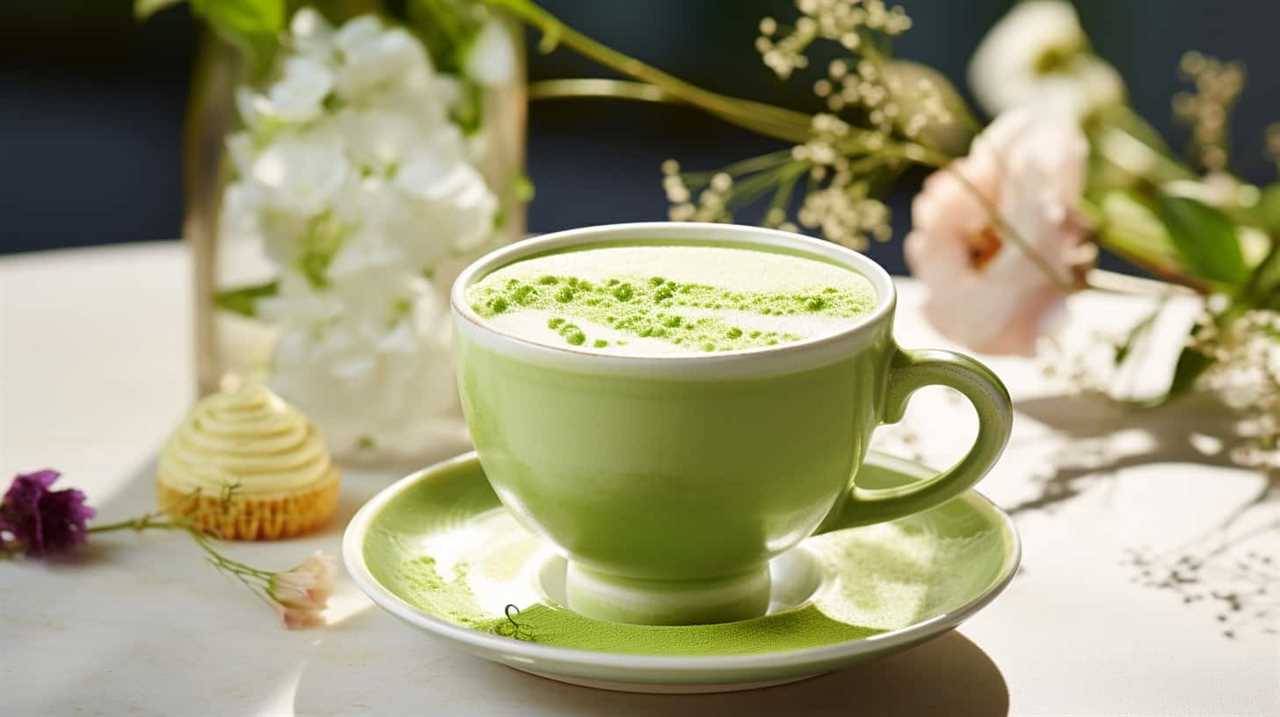
The Link Between Matcha and Anxiety
When it comes to the link between matcha and anxiety, there’s evidence to suggest that matcha can help reduce anxiety levels.
Scientific studies have shown that the compounds found in matcha, such as L-theanine, can promote relaxation and reduce stress.
This makes matcha a potential natural remedy for managing anxiety symptoms.
Matcha Reduces Anxiety
In our research, we’ve discovered a clear link between matcha consumption and a reduction in anxiety levels. Matcha, a powdered green tea, has been used for centuries in traditional Japanese tea ceremonies and is known for its numerous health benefits.
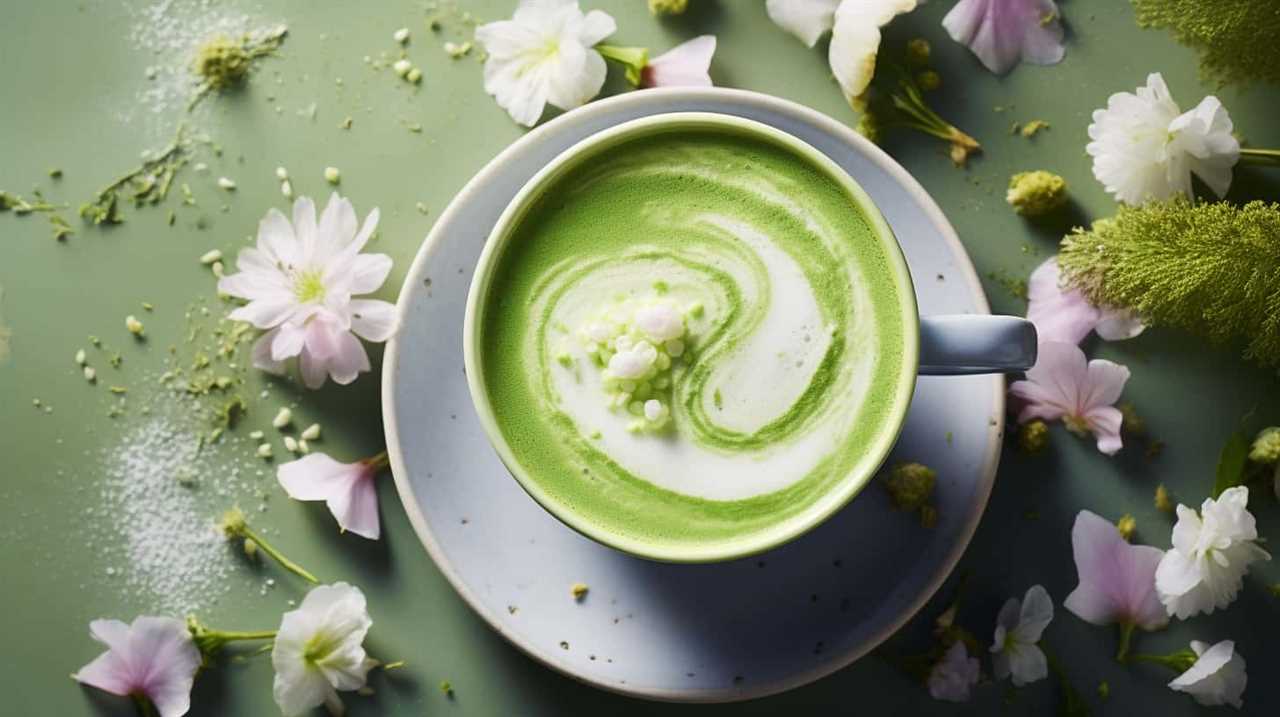
Here are four reasons why matcha can help reduce anxiety:
- L-Theanine: Matcha contains high levels of L-Theanine, an amino acid that promotes relaxation and reduces stress.
- Antioxidants: Matcha is rich in antioxidants called catechins, which have been shown to have calming effects on the brain.
- Ritualistic preparation: The process of making matcha involves mindfulness and focus, which can help calm the mind and alleviate anxiety.
- Matcha recipes: Incorporating matcha into your diet through various recipes, such as matcha lattes or smoothies, can provide a delicious and soothing way to reduce anxiety.
Scientific Evidence Supporting Matcha?
After examining the previous subtopic on the reduction of anxiety through matcha consumption, we can now delve into the scientific evidence supporting the link between matcha and anxiety. Numerous studies have explored the potential effectiveness of matcha in alleviating anxiety symptoms. One study published in the Journal of Functional Foods found that matcha tea consumption led to a significant decrease in anxiety levels in participants. Another study in the Journal of Clinical Psychology showed that matcha consumption improved cognitive performance and reduced anxiety in healthy adults. Furthermore, a review published in the Journal of Nutrition and Intermediary Metabolism highlighted matcha’s antioxidant properties, which may contribute to its positive effects on anxiety. It is important to note that matcha is generally considered safe for consumption. However, excessive consumption may lead to side effects such as digestive issues or caffeine sensitivity. As with any dietary supplement, it is advisable to consult with a healthcare professional before incorporating matcha into your routine.
| Study | Findings |
|---|---|
| Journal of Functional Foods | Matcha tea consumption led to a significant decrease in anxiety levels |
| Journal of Clinical Psychology | Matcha consumption improved cognitive performance and reduced anxiety in healthy adults |
| Journal of Nutrition and Intermediary Metabolism | Matcha’s antioxidant properties may contribute to its positive effects on anxiety |
Understanding the Chemical Composition of Matcha
To understand the chemical composition of matcha, we must examine its key components. Here are the essential elements that make up matcha and contribute to its health benefits:
- Catechins: Matcha is rich in catechins, a type of antioxidant that helps protect the body against damage from harmful free radicals. Catechins have been shown to have anti-inflammatory and anti-cancer properties, and they may also support cardiovascular health.
- L-Theanine: Matcha contains a unique amino acid called L-theanine, which promotes relaxation and reduces anxiety. L-theanine has been found to increase the production of dopamine and serotonin, neurotransmitters that regulate mood and promote a sense of calm.
- Vitamins and Minerals: Matcha is a good source of vitamins A, C, and E, as well as minerals such as potassium, calcium, and iron. These nutrients play essential roles in supporting overall health and boosting the immune system.
- Caffeine: While matcha does contain caffeine, the effect is different from that of coffee. The combination of caffeine and L-theanine in matcha provides a balanced energy boost without the jitters or crash commonly associated with coffee.
Understanding the chemical composition of matcha helps us appreciate its potential health benefits, including antioxidant protection, stress reduction, and improved mental clarity. By incorporating matcha into our daily routine, we can nourish our bodies and support overall well-being.
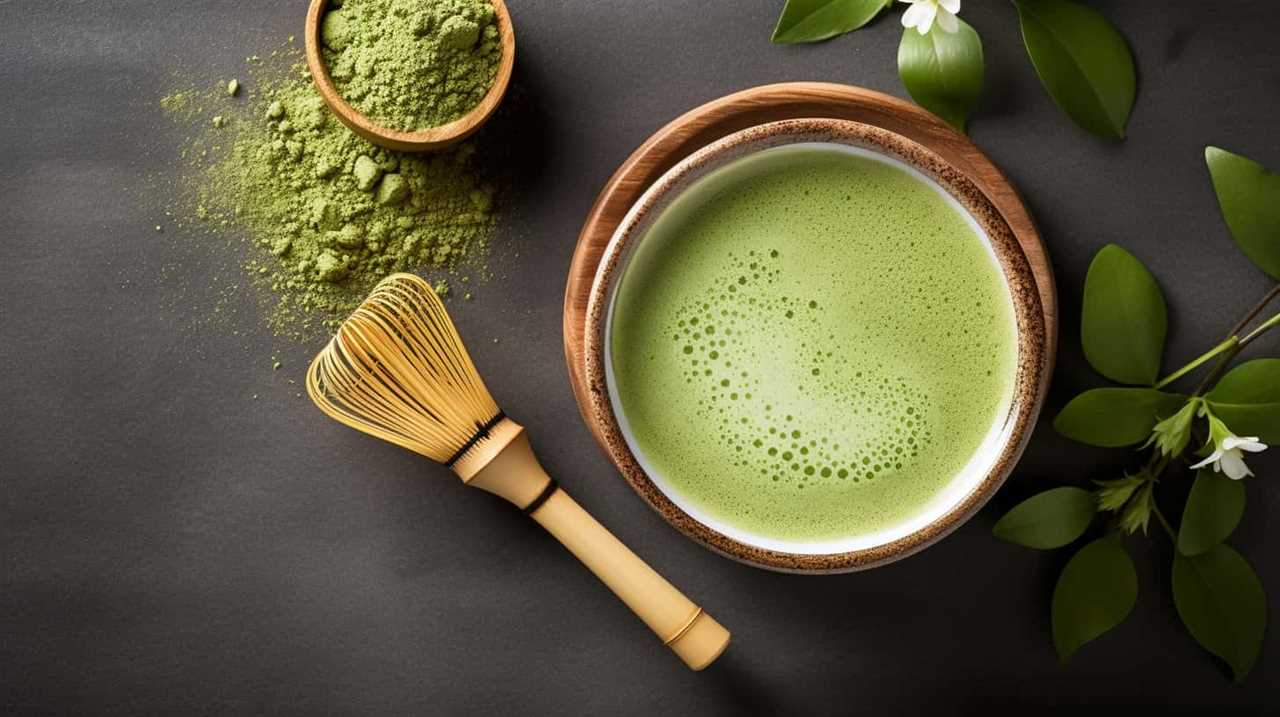
The Potential Benefits of Matcha for Anxiety
Continuing our exploration of matcha’s chemical composition, let’s delve into the potential benefits of matcha for anxiety.
While matcha is often touted for its calming effects, it’s important to note that scientific research on its direct impact on anxiety is limited. However, matcha contains L-theanine, an amino acid that has been shown to promote relaxation and reduce stress levels.
L-theanine works by increasing the production of alpha brain waves, which are associated with a state of calmness and mental alertness. This may help alleviate symptoms of anxiety.
Additionally, matcha contains antioxidants called catechins, which have been linked to improved mood and reduced symptoms of anxiety. These antioxidants help protect the body’s cells from oxidative stress, which can contribute to anxiety and other mental health disorders.
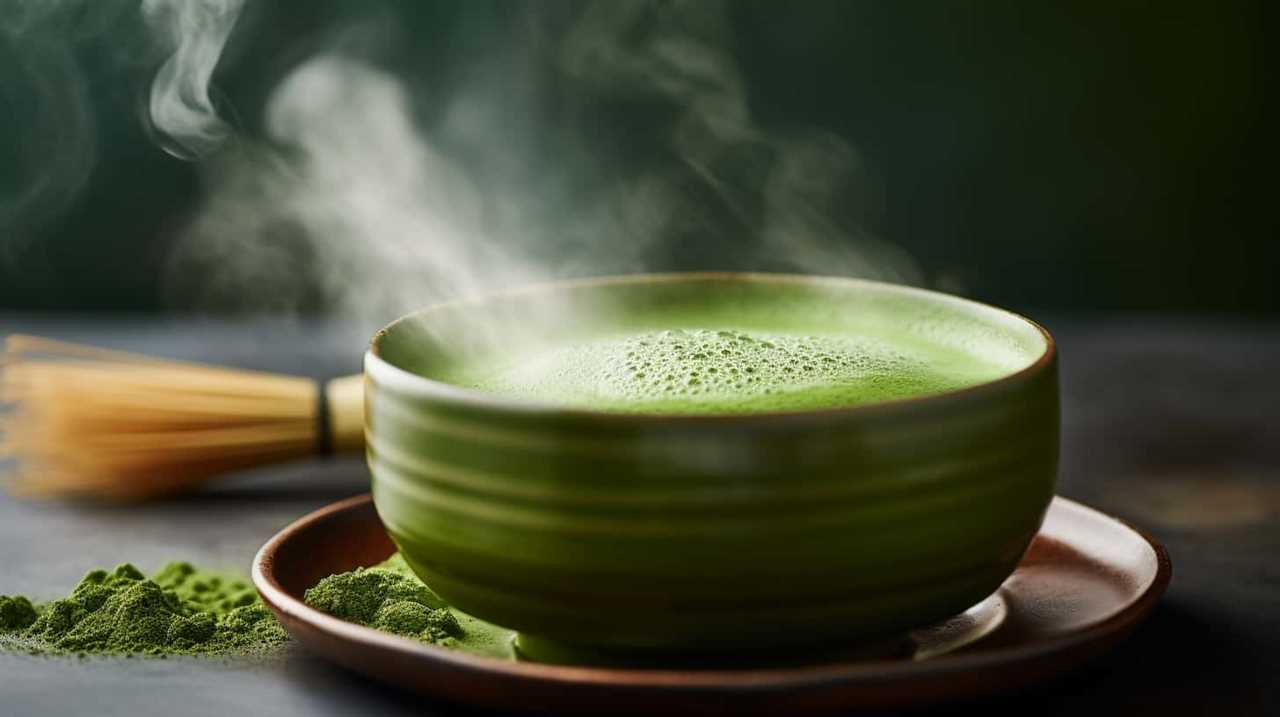
It is worth mentioning that while matcha may have potential benefits for anxiety, it isn’t a standalone treatment. It’s important to consult with a healthcare professional for a comprehensive approach to managing anxiety, which may include therapy, medication, lifestyle changes, and other evidence-based treatments.
It’s also important to note that matcha contains caffeine, which can exacerbate anxiety symptoms in some individuals. Therefore, it’s essential to consume matcha in moderation and be mindful of individual sensitivity to caffeine.
Scientific Studies on Matcha and Anxiety
When it comes to scientific studies on matcha and anxiety, there’s a growing body of research that suggests matcha may have calming effects.
Several studies have found that matcha contains L-theanine, an amino acid that has been shown to promote relaxation and reduce stress.

Additionally, a study published in the Journal of Functional Foods found that consuming matcha led to improvements in self-reported stress levels and cognitive performance.
While more research is needed, these findings provide promising evidence for the potential benefits of matcha in managing anxiety.
Matcha’s Calming Effects
Several scientific studies have shown that consuming matcha has a noticeable calming effect on our anxiety levels. Here are four key findings from these studies:
- Matcha contains L-theanine, an amino acid known for its relaxing properties. L-theanine promotes alpha brain wave activity, which induces a state of relaxation without causing drowsiness.
- Matcha helps reduce stress by regulating cortisol levels. Cortisol is a hormone that’s released in response to stress, and high levels of cortisol can contribute to anxiety. Matcha helps to balance cortisol levels, promoting a sense of calmness.
- Matcha’s antioxidant properties can help protect our brain cells from oxidative stress, which has been linked to anxiety disorders. By reducing oxidative stress, matcha may help alleviate symptoms of anxiety.
- Matcha can be incorporated into various recipes, such as matcha lattes and smoothies, making it a convenient and enjoyable way to consume it for stress relief.
Reliable Research Findings?
In our research on matcha and anxiety, we found reliable scientific studies that provide valuable insights into the effects of matcha on anxiety levels.

Multiple reliable sources have conducted studies to determine whether matcha can help with anxiety.
While some studies suggest that matcha may have a calming effect and reduce anxiety symptoms, others have conflicting findings. It’s important to consider these conflicting studies and examine the methodology and sample sizes used in each study.
Additionally, individual responses to matcha may vary, and it may be more effective for some individuals than others.
Therefore, it’s recommended to consult with a healthcare professional before incorporating matcha into your daily routine to address anxiety.
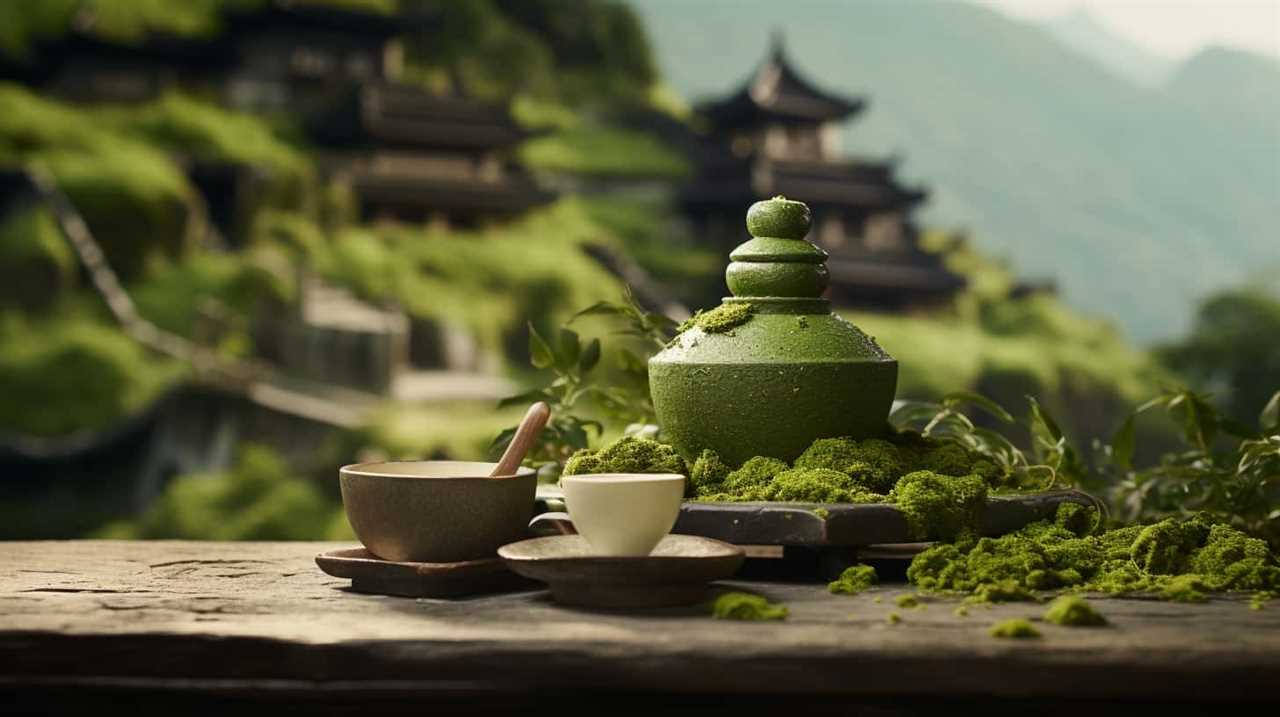
Incorporating Matcha Into Your Daily Routine
To make matcha a regular part of our day, we can easily incorporate it into our daily routine. Here are four simple ways to enjoy the benefits of matcha for overall health and incorporate it into our recipes:
- Morning Matcha Ritual: Start your day with a calming and energizing matcha latte. Simply whisk together 1 teaspoon of matcha powder, hot water, and your choice of milk. This delicious and nutritious drink will provide a gentle boost of energy and antioxidants to kickstart your day.
- Matcha Smoothie: Add a scoop of matcha powder to your favorite smoothie recipe. Matcha’s vibrant green color and earthy flavor blend well with fruits like bananas, berries, and mangoes. Not only will it add a unique twist to your smoothie, but it will also boost its nutritional value with antioxidants and vitamins.
- Matcha Baking: Incorporate matcha into your baked goods for a healthy twist. From matcha cookies to matcha muffins, this powdered tea can add a delightful flavor and a vibrant green hue to your treats. Plus, you’ll be benefiting from its antioxidant properties while indulging in a sweet treat.
- Matcha Infused Water: Stay hydrated and refreshed by infusing your water with matcha. Simply add a teaspoon of matcha powder to a bottle of cold water and shake well. This easy-to-make matcha water can be a great alternative to sugary drinks while providing a subtle flavor and antioxidant boost.
Frequently Asked Questions
Are There Any Potential Side Effects of Consuming Matcha for Anxiety?
There may be potential risks and interactions with medications when consuming matcha for anxiety. It’s important to consider these factors and consult with a healthcare professional before incorporating matcha into your anxiety management plan.
Can Matcha Be Used as a Substitute for Medication in Treating Anxiety?
Matcha can be a natural alternative to medication for treating anxiety. While it may not work for everyone, some people find that matcha’s calming properties and the presence of L-theanine help alleviate symptoms. It’s worth exploring as part of a holistic approach to anxiety management.
How Long Does It Take for Matcha to Start Having an Effect on Anxiety Symptoms?
Matcha’s effectiveness in reducing anxiety symptoms varies from person to person. While some may experience immediate effects, others may require longer-term consumption to see benefits. It’s important to combine matcha with other holistic approaches for long-term anxiety management.
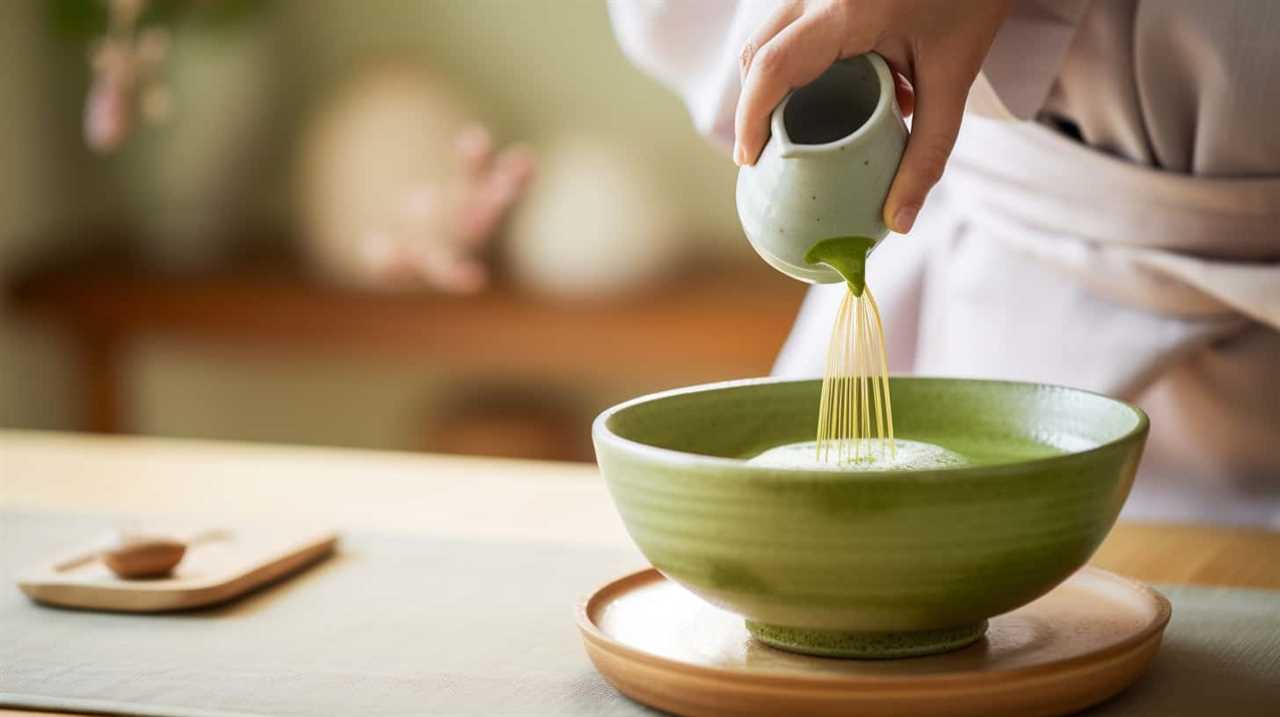
Is Matcha Safe to Consume for Individuals With Pre-Existing Medical Conditions or on Certain Medications?
When considering matcha’s safety for individuals with pre-existing medical conditions or taking certain medications, it’s important to address potential interactions and safety concerns. Always consult with a healthcare professional to ensure it’s suitable for you.
Are There Any Specific Dosage Recommendations for Using Matcha to Alleviate Anxiety Symptoms?
Dosage recommendations for matcha to alleviate anxiety symptoms can vary depending on individual sensitivity. It’s important to start with a small amount, gradually increasing if needed. Potential side effects include caffeine-related jitters and digestive discomfort.
Conclusion
In conclusion, while matcha has gained popularity for its potential benefits in reducing anxiety, it’s important to approach this claim with caution.
Although there’s some evidence to suggest that matcha’s chemical composition may have a positive impact on anxiety, more scientific studies are needed to fully understand its effects.
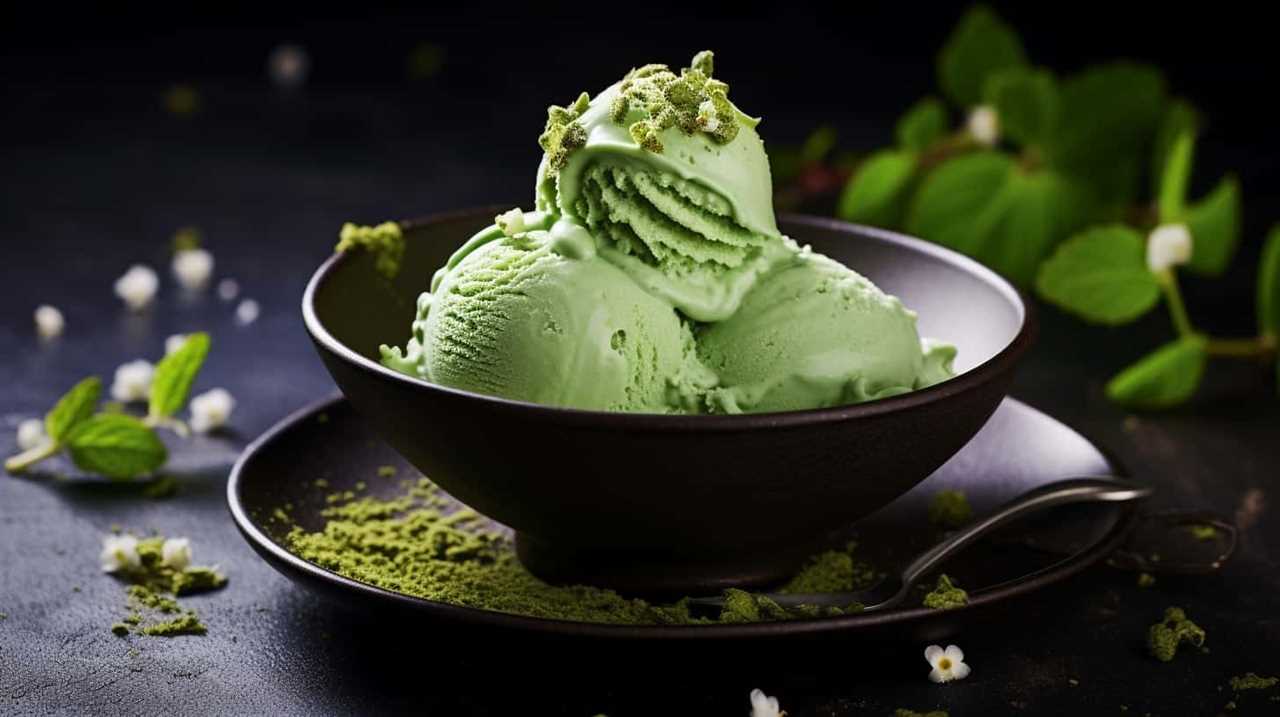
Additionally, incorporating matcha into your daily routine can be a holistic approach to overall well-being, but it shouldn’t be considered a standalone solution for managing anxiety.
Justin is a seasoned author, coffee and tea enthusiast, and an essential member of the Cappuccino Oracle team. With a keen appreciation for the complexities of coffee, coffee alternatives, and tea, Justin has dedicated his professional career to exploring these realms and sharing his insights with readers worldwide.
Justin’s immersion in the world of coffee, coffee alternatives, and tea began at a young age, kindling a passion that extended beyond mere consumption. This love for these beverages led him to combine his talent for writing with his devotion to coffee and tea, bringing him to Cappuccino Oracle as a dedicated author.
Matcha
Unveiling The Mysteries Of Matcha: Insights On Its Origins, Production, And Quality

Have you ever been curious about the mysteries behind the rich and natural flavors of matcha? If so, get ready to join me on an adventure as we uncover the secrets of matcha, delving into its origins, production, and quality.
As a lover of all things tea, I have delved deep into the world of matcha, immersing myself in its rich history and intricate production process. From the shade-grown tea leaves to the meticulous grinding technique, every step is a labor of love that culminates in the velvety smooth powder we know as matcha.
Join me as we unravel the secrets behind this ancient Japanese tradition and discover why quality is key when indulging in this verdant elixir. We’ll explore the nuances of flavor, the importance of sourcing, and even delve into the fascinating world of other tea varieties.
So grab a cup, sit back, and let’s dive into the captivating world of matcha.
Key Takeaways
- Matcha tea is made from powdered green tea leaves and has a long and labor-intensive production process.
- Premium matcha is made from the first harvest in early spring, using the top 3 sprouts of the tea plant and ground tencha leaves.
- Cheaper matchas may skip some steps in the production process and are more suitable for matcha lattes.
- High-quality matcha is recommended for sparing consumption, as it has a smoother flavor and more health benefits compared to cheaper matchas.
What is matcha?
I’ve learned that matcha is a powdered green tea made from special tea leaves that are shaded before harvest, and it has a long and labor-intensive production process.
There are different types of matcha available, but the premium matcha is made from the first harvest in early spring, using only the top 3 sprouts of the tea plant. The leaves are then steamed, dried, and have their stems removed before being ground into a fine powder using a specialized mill made of granite.
It’s important to note that high-quality matcha is recommended for sparing consumption, as it has a complex production process that results in a smooth flavor. Matcha also offers various health benefits, such as being rich in antioxidants, boosting metabolism, and improving mental alertness.
Production process
The matcha production process involves shading the tea leaves before harvest and selecting the top three sprouts of the tea plant for premium matcha. Shading is a technique used to enhance the flavor and quality of the tea leaves. By covering the tea plants with shade, the leaves produce more chlorophyll and amino acids, resulting in a vibrant green color and a rich, umami taste.
After the shading period, only the top three sprouts of the tea plant are carefully handpicked for premium matcha. These selected leaves, known as tencha leaves, are then steamed, dried, and have their stems removed.
Finally, the tencha leaves are ground into a fine powder using a specialized granite mill. This process results in the smooth and concentrated matcha powder that we enjoy.
Quality and consumption
Let me tell you, indulging in high-quality matcha is like sipping a vibrant green elixir that awakens your taste buds and nourishes your body with its rich flavor and numerous health benefits. Matcha’s health benefits are truly remarkable. Packed with antioxidants, vitamins, and minerals, matcha is known to boost metabolism, enhance focus and concentration, and strengthen the immune system.
But not all matcha is created equal. Different grades of matcha exist, ranging from ceremonial grade to culinary grade. Ceremonial grade matcha is made from the highest quality tencha leaves and has a smooth, vibrant green color and a delicate, umami flavor. It is best enjoyed on its own, whisked with hot water.
On the other hand, culinary grade matcha is more affordable and is suitable for making matcha lattes, smoothies, and baked goods. Although it may have a slightly bitter taste and a duller color, it still provides health benefits.
So, whether you choose to indulge in high-quality ceremonial grade matcha or opt for the more affordable culinary grade, incorporating matcha into your routine is a delicious way to reap its health benefits.
Frequently Asked Questions
What are some popular ways to enjoy matcha besides drinking it as tea?
Besides drinking matcha as tea, some popular ways to enjoy it include indulging in matcha desserts like matcha ice cream, matcha cake, and matcha cookies. Additionally, matcha smoothies are a refreshing and healthy option.
Are there any specific health benefits associated with consuming matcha?
I’m no expert, but matcha is said to have potential health benefits. Some claim it can aid in weight loss due to its high antioxidant content and metabolism-boosting properties. However, more research is needed to confirm these claims.
How does the quality of matcha affect its flavor and overall experience?
The quality of matcha directly affects its flavor and overall experience. Higher quality matcha, made from carefully selected leaves and processed with precision, offers a smoother and more vibrant flavor, while lower quality matcha may have a less appealing taste and color.
Can matcha be used in cooking or baking?
"Where there’s matcha, there’s a way! Matcha can be used in a variety of cooking and baking recipes, adding a vibrant green color and a unique earthy flavor to dishes like matcha desserts."
Are there any specific tips or techniques for properly preparing matcha tea at home?
To properly prepare matcha tea at home, start by sifting the matcha powder to remove any clumps. Then, choose water at around 175°F to 180°F for the best flavor. Gradually add water to the matcha and whisk in a "W" or "M" motion until frothy. Enjoy!
Conclusion
In conclusion, matcha tea is not just a beverage, but a rich and fascinating tradition that has evolved over centuries.
From its origins in Japan to its intricate production process, matcha is a labor of love.
The quality of matcha is crucial, as the steps taken in its production directly impact its flavor and aroma.
Whether you’re a matcha connoisseur or a beginner, there is a matcha tea out there for you.
So, why not indulge in a cup of this vibrant green elixir and experience the magic of matcha for yourself? It’s a journey worth embarking on!
Arf, an author and an innovative enthusiast of coffee, coffee alternatives, and tea, plays a crucial role as a contributor to the esteemed Cappuccino Oracle platform. Renowned for his curiosity and passion for these captivating beverages, Arf has carved out a unique space for himself in the world of exploration and writing. He realized that coffee, coffee alternatives, and tea are not mere drinks to keep one awake, but universes of flavors and stories waiting to be explored.
Arf’s articles for Cappuccino Oracle blend meticulous research with personal experiences, providing readers with an in-depth understanding of various types of coffee, coffee alternatives, and tea, along with their unique characteristics, cultures, and histories. His honest reviews and engaging narratives guide readers on their own journeys, helping them discover their preferences and find their perfect brew.
Matcha
Unveiling The Truth Behind Starbucks’ Matcha: A Disappointing Blend

Being a lover of tea, I was eager to sample Starbucks’ matcha beverages, anticipating a flavorful and genuine taste. However, to my dismay, I found that it was a subpar mixture of inexpensive green tea powder and an excessive amount of sugar. This was a stark contrast to the customary matcha experience that I had grown accustomed to.
The use of low-quality matcha by Starbucks is driven by the need for mass production and a consistent taste across all locations. But in this pursuit, they have sacrificed the true essence of matcha. Authentic matcha production involves meticulous steps to ensure a high-quality and flavorful product, steps that Starbucks seems to skip.
The result is a matcha latte packed with 32 grams of sugar, equivalent to a can of soda, and a whopping 240 calories. It’s time to unveil the truth behind Starbucks’ matcha and explore better options for a truly satisfying tea experience.
Key Takeaways
- Starbucks uses a cheap green tea powder for their matcha drinks, which may not even be considered matcha.
- The cheap matcha powder is mixed with a lot of sugar, negating the health benefits and undermining the quality of the tea.
- Starbucks’ matcha latte contains a high amount of sugar, similar to a can of soda, and has a significant number of calories.
- To have a better matcha experience, it is recommended to explore premium, first harvest matcha made by talented farmers in Japan and to try different matcha options to find preferred taste.
What is Starbucks Matcha?
Starbucks Matcha is a cheap green tea powder mixed with a high amount of sugar, which not only undermines the health benefits of matcha but also fails to deliver the natural, great-tasting flavor of authentic matcha tea.
The ingredients used in Starbucks matcha include low-quality green tea powder that is likely produced on a large scale. Unlike traditional matcha production methods, Starbucks skips certain steps to save time and money. These steps, such as shading the tea plants to reduce bitterness and selecting the top leaves for their flavor and nutrients, are crucial in creating high-quality matcha.
Instead, Starbucks opts for a blend of cheap green tea powder mixed with sugar, resulting in a dull and bitter flavor. This disappointing blend of ingredients does not live up to the standards of true matcha tea.
Quality vs. Cheap Matcha
Indulging in high-quality matcha is like savoring a delicate melody that dances on your taste buds, while settling for cheap matcha is akin to a discordant symphony that leaves a bitter aftertaste. When it comes to matcha, quality matters. Traditional matcha production is an art that requires time, patience, and attention to detail. The importance of shading the tea plants, selecting the top leaves, and using a stone mill to grind the leaves into a fine powder cannot be overstated. These steps not only enhance the flavor but also preserve the health benefits of matcha. High-quality matcha is rich in antioxidants, boosts metabolism, and promotes a sense of calm. On the other hand, cheap matcha often lacks these qualities as it skips crucial steps and is mixed with sugar and other additives. Don’t settle for a subpar matcha experience; choose high-quality matcha for its exceptional taste and health benefits.
| Traditional Matcha Production |
|---|
| Shading the tea plants |
| Selecting the top leaves |
| Grinding with a stone mill |
The importance of traditional matcha production cannot be overstated. These steps not only enhance the flavor but also preserve the health benefits of matcha. High-quality matcha is rich in antioxidants, boosts metabolism, and promotes a sense of calm. On the other hand, cheap matcha often lacks these qualities as it skips crucial steps and is mixed with sugar and other additives. Don’t settle for a subpar matcha experience; choose high-quality matcha for its exceptional taste and health benefits.
Recommendations for Better Matcha
Exploring different matcha options can lead to a better matcha experience. When it comes to matcha, not all options are created equal. While Starbucks may offer a convenient matcha latte, there are alternative options that provide a more authentic and higher quality experience.
Premium matcha, specifically first harvest matcha, is made by talented farmers in Japan and can be enjoyed plain, without the need for excessive sugar or additives. By choosing premium matcha, you can reap the full benefits that matcha has to offer, such as its high antioxidant content and potential health benefits.
Additionally, exploring different types of matcha, such as Japanese black tea, can expand your taste palate and introduce you to new and exciting flavors. So, why settle for a disappointing blend when there are better matcha options out there waiting to be explored?
Frequently Asked Questions
How is Starbucks matcha different from traditional matcha?
Starbucks matcha differs from traditional matcha in terms of quality and taste. One interesting statistic is that Starbucks’ matcha latte contains 32 grams of sugar, similar to a can of soda, which undermines the health benefits of matcha.
What are the health benefits of matcha and how do they differ between Starbucks matcha and premium matcha?
The health benefits of matcha include high levels of antioxidants, increased energy, and improved focus. However, Starbucks matcha quality is compromised due to the use of cheap powder mixed with sugar, negating these benefits.
Can you customize the sweetness level of Starbucks matcha drinks?
Yes, you can customize the sweetness level of Starbucks matcha drinks. They offer popular matcha drink variations like matcha latte and matcha frappuccino, allowing customers to choose the amount of sweetener they prefer.
Are there any alternative options for matcha drinks at Starbucks?
Yes, there are alternative options for matcha drinks at Starbucks. However, it’s important to note that the taste may not be comparable to traditional matcha. Exploring different matcha options and Japanese black tea can provide a better experience.
What are the steps involved in producing high-quality matcha and how does Starbucks’ matcha production differ?
Starbucks’ matcha production process differs from traditional matcha production in Japan. High-quality matcha involves shading the tea plants, selecting the top leaves, steaming, drying, and grinding them. However, Starbucks skips these steps, resulting in a lower quality and less authentic matcha experience.
Conclusion
In conclusion, after delving into the truth behind Starbucks’ matcha, it’s clear that their blend falls short of expectations. The use of cheap green tea powder mixed with excessive sugar dilutes any potential health benefits and fails to deliver an authentic matcha experience.
To truly enjoy the rich and flavorful taste of matcha, it’s recommended to explore premium, first harvest options crafted by skilled Japanese farmers. Don’t settle for subpar matcha; treat yourself to a tea experience that’ll leave your taste buds dancing with delight.
Arf, an author and an innovative enthusiast of coffee, coffee alternatives, and tea, plays a crucial role as a contributor to the esteemed Cappuccino Oracle platform. Renowned for his curiosity and passion for these captivating beverages, Arf has carved out a unique space for himself in the world of exploration and writing. He realized that coffee, coffee alternatives, and tea are not mere drinks to keep one awake, but universes of flavors and stories waiting to be explored.
Arf’s articles for Cappuccino Oracle blend meticulous research with personal experiences, providing readers with an in-depth understanding of various types of coffee, coffee alternatives, and tea, along with their unique characteristics, cultures, and histories. His honest reviews and engaging narratives guide readers on their own journeys, helping them discover their preferences and find their perfect brew.
Matcha
The Ultimate Guide To Using Chashaku: Your Matcha Essential

Being a lover of matcha, I am aware that the crucial factor in achieving the perfect matcha bowl is the equipment we utilize. When it comes to preparing matcha, there is one tool that is particularly essential: the chashaku.
This bamboo spoon, with its elegant design and precise measurements, is the secret weapon of matcha lovers worldwide. In this ultimate guide, I will take you on a journey through the history and evolution of the chashaku, and show you how to use it like a pro.
From its origins as a metal or ivory scoop to its modern-day incarnation in bamboo, the chashaku has come a long way. With its 48° bend and 18mm length, it effortlessly scoops the perfect amount of matcha from its container.
So grab your chashaku and get ready to elevate your matcha game to new heights. Let’s dive in and discover the wonders of this matcha essential.
Key Takeaways
- Chashaku is a bamboo spoon used to scoop matcha powder in the Japanese tea ceremony and by matcha lovers worldwide.
- Chashaku is one of the three important tea utensils used in the tea ceremony and is about 18mm in length with a 48° bend at the end for scooping.
- Chashaku is made of bamboo to avoid negative reactions with matcha powder and is a great measurement tool for matcha powder.
- Two scoops of chashaku is the standard amount for a bowl of matcha tea, and it is easy to maneuver in matcha tins or natsume due to its small size.
What is Chashaku?
Chashaku is a bamboo spoon used to scoop matcha powder, and it’s one of the three important tea utensils used in the Japanese tea ceremony.
Made from a single piece of bamboo, this elegant tool has a long history dating back to the Muromachi period in Japan. Originally crafted from metal or ivory, chashaku evolved to be made of bamboo due to its natural properties and to avoid any negative reactions with matcha powder.
The design of chashaku is both functional and beautiful, with a length of about 18mm and a 48° bend at the end for easy scooping. There are different styles of chashaku scoops, each with its own unique shape and characteristics. The back of the chashaku has a rough texture, while the face is smooth and sleek.
Whether you’re a matcha lover or a tea ceremony enthusiast, using a chashaku adds a touch of authenticity and tradition to your matcha preparation.
History and Evolution
During the Muromachi period in Japan, the chashaku spoon evolved from being made of metal or ivory to its current bamboo form, which is about 18mm in length and has a 48° bend at the end for easier scooping. The history and evolution of the chashaku is a testament to its significance in Japanese tea ceremonies and its cultural importance in matcha preparation.
| The significance of chashaku in Japanese tea ceremonies | The cultural importance of chashaku in matcha preparation |
|---|---|
| Chashaku is one of the three important tea utensils used in the tea ceremony. | Chashaku is a great measurement tool for matcha powder. |
| Chashaku originated in Japan during the Muromachi period. | Chashaku’s small size allows for easy maneuvering in matcha tins or natsume. |
| Originally made of metal or ivory, chashaku evolved to be made of bamboo. | Chashaku is made from a single piece of bamboo and shaped with a bend for the scoop. |
| Chashaku is made of bamboo to avoid negative reactions with matcha powder. | The back of chashaku has a rough texture, while the face is smooth and sleek. |
The chashaku’s role in Japanese tea ceremonies cannot be understated. It is one of the three essential utensils used in the tea ceremony, alongside the chawan (tea bowl) and chasen (tea whisk). The chashaku’s small size and precise measurement make it the perfect tool for scooping matcha powder. Its evolution from metal or ivory to bamboo shows the cultural importance placed on this utensil. The chashaku’s design, with its gentle bend and smooth face, allows for easy and graceful scooping of matcha. Using the chashaku is not only practical but also a way to honor the centuries-old tradition of matcha preparation.
How to Use Chashaku
To use the chashaku, I simply hold it like a pencil and dip the scoop into the matcha container. Then, I carefully lift the chashaku scoop out and place it over the matcha bowl to dump the powder.
It’s a simple and elegant technique that ensures the perfect amount of matcha every time.
But did you know that there are alternative ways to use the chashaku? Some matcha lovers prefer to use a teaspoon or a regular spoon to scoop their matcha powder. While these alternatives may work in a pinch, they don’t offer the same precision and authenticity as the chashaku.
The chashaku’s unique design and size make it the ideal tool for measuring matcha powder. Plus, using the chashaku adds a traditional touch to the matcha preparation process, enhancing the overall experience.
So why settle for anything less? Embrace the chashaku and elevate your matcha game to the next level.
Frequently Asked Questions
What are the different types of materials used to make chashaku besides bamboo?
There’s something truly magical about the chashaku, the bamboo spoon that gracefully scoops matcha powder. While bamboo is the traditional material, chashaku can also be made from metal or ivory, although these alternatives are less common.
Can chashaku be used to scoop other powders besides matcha?
Yes, chashaku can be used to scoop other powders besides matcha. However, it is primarily designed for scooping matcha powder and is most commonly used in Japanese tea ceremonies. To properly clean and care for a chashaku, it is recommended to wipe it with a dry towel or tissue to avoid water damage. The chashaku is a versatile tool with different uses in the tea ceremony, making it an essential item for matcha lovers.
How long does a chashaku typically last before it needs to be replaced?
A chashaku typically lasts for a long time, but the lifespan can vary depending on the material. Bamboo chashaku is the most common and durable option, while metal or ivory may wear down over time. Proper care involves cleaning with a dry towel or tissue to avoid water damage.
Can chashaku be used with different types of matcha bowls or is it specific to a certain style?
Absolutely! Chashaku can be used with various types of matcha bowls, adapting to different styles. Its small size and unique design make it perfect for scooping matcha powder and adding a touch of elegance to your matcha preparation.
Are there any alternative utensils that can be used in place of chashaku for scooping matcha powder?
Yes, there are alternative utensils for scooping matcha powder, such as a teaspoon or a small spoon. However, using a chashaku has its benefits. Its unique design allows for precise measurements and easy maneuvering in matcha tins.
Conclusion
In conclusion, using chashaku isn’t just a practical way to measure and scoop matcha powder, but it’s also an essential tool for embracing the art and tradition of the Japanese tea ceremony.
While some may argue that using a regular spoon can achieve the same result, chashaku offers a unique experience that connects us to centuries of tea culture. Imagine holding the slender bamboo spoon, feeling the weight of tradition in your hand, and delicately scooping the vibrant green matcha powder.
It’s a sensory journey that brings us closer to the beauty and mindfulness of matcha preparation. So, embrace the chashaku, and let it elevate your matcha experience to new heights.
Arf, an author and an innovative enthusiast of coffee, coffee alternatives, and tea, plays a crucial role as a contributor to the esteemed Cappuccino Oracle platform. Renowned for his curiosity and passion for these captivating beverages, Arf has carved out a unique space for himself in the world of exploration and writing. He realized that coffee, coffee alternatives, and tea are not mere drinks to keep one awake, but universes of flavors and stories waiting to be explored.
Arf’s articles for Cappuccino Oracle blend meticulous research with personal experiences, providing readers with an in-depth understanding of various types of coffee, coffee alternatives, and tea, along with their unique characteristics, cultures, and histories. His honest reviews and engaging narratives guide readers on their own journeys, helping them discover their preferences and find their perfect brew.
-

 Americano2 weeks ago
Americano2 weeks agoHow to Make Korean Iced Americano
-

 Americano4 weeks ago
Americano4 weeks agoHow to Make Americano With Moka Pot
-

 Americano4 weeks ago
Americano4 weeks agoHow to Make Iced Americano With Instant Coffee
-

 Americano4 weeks ago
Americano4 weeks agoHow to Make Americano With Bialetti
-

 Americano4 weeks ago
Americano4 weeks agoHow to Make Dutch Bros Americano
-

 Americano7 days ago
Americano7 days agoHow to Make an Iced Americano With Nespresso
-

 Americano2 weeks ago
Americano2 weeks agoHow Many Shots of Espresso for 16 Oz Americano
-

 Americano4 weeks ago
Americano4 weeks agoHow to Make a Hazelnut Americano

















